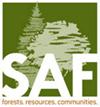Whole-Tree Green Density Equations for Loblolly and Slash Pine Trees
IF 1.5
4区 农林科学
Q2 FORESTRY
引用次数: 0
Abstract
Using extensive legacy and new datasets, two equations of whole-tree green density, defined as the ratio of the green weight of stem wood with bark (GWob) divided either by the stem outside-bark volume (Vob) or by the stem inside-bark volume (Vib), were developed along with individual tree Vob, Vib, and GWob equations for loblolly and slash pines. The green density equations indicated that the GWob/Vob ratio increases while the GWob/Vib ratio decreases with an increase in tree size for both species. The transition from low-intensity management to intensive management has a notable impact on tree green weight characteristics. Generally, trees from older established plantations exhibited a higher GWob/Vob ratio compared with trees from more recently established plantations, spanning both loblolly and slash pines. Study Implications: Derived whole-tree green density equations, alongside updated stem green weight and volume equations, are valuable tools for estimating the volume and green weight of entire stem boles, facilitating volume-to-green-weight conversion for specific sections for loblolly and slash pines, the primary commercial timber species in the southern United States.小叶松和斜叶松树的整树绿化密度方程
利用大量的遗留数据和新数据集,为龙柏和斜叶松树开发了两个全树绿化密度方程(定义为带树皮的茎干木材绿化重量(GWob)除以茎干外树皮体积(Vob)或茎干内树皮体积(Vib)的比率)以及单棵树的 Vob、Vib 和 GWob 方程。绿化密度方程表明,两种松树的 GWob/Vob 比值都会随着树体的增大而增大,而 GWob/Vib 比值则会随着树体的增大而减小。从低强度管理过渡到高强度管理对树木的绿重特性有显著影响。一般来说,与新近建立的人工林中的树木相比,建立时间较长的人工林中的树木表现出更高的 GWob/Vob 比率,其中既包括龙柏也包括斜纹松。研究意义:推导出的全树绿化密度方程以及更新的茎杆绿重和体积方程是估算整个茎杆树干体积和绿重的宝贵工具,有助于将美国南部主要商业用材树种--龙柏和斜纹松特定部分的体积转换为绿重。
本文章由计算机程序翻译,如有差异,请以英文原文为准。
求助全文
约1分钟内获得全文
求助全文
来源期刊

Forest Science
农林科学-林学
CiteScore
2.80
自引率
7.10%
发文量
45
审稿时长
3 months
期刊介绍:
Forest Science is a peer-reviewed journal publishing fundamental and applied research that explores all aspects of natural and social sciences as they apply to the function and management of the forested ecosystems of the world. Topics include silviculture, forest management, biometrics, economics, entomology & pathology, fire & fuels management, forest ecology, genetics & tree improvement, geospatial technologies, harvesting & utilization, landscape ecology, operations research, forest policy, physiology, recreation, social sciences, soils & hydrology, and wildlife management.
Forest Science is published bimonthly in February, April, June, August, October, and December.
 求助内容:
求助内容: 应助结果提醒方式:
应助结果提醒方式:


